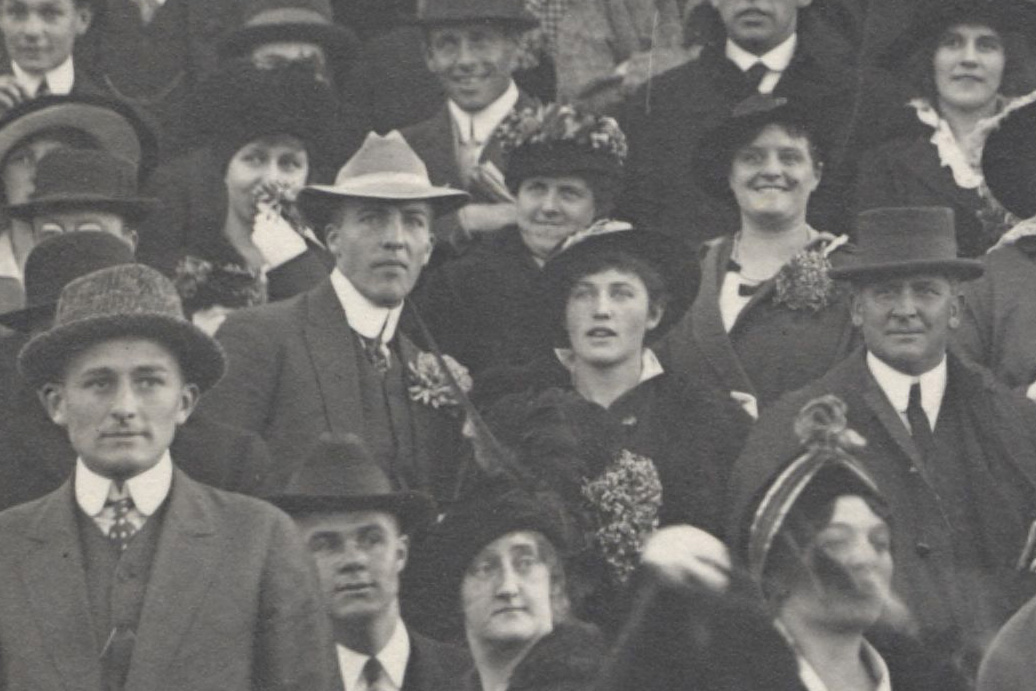Stanford student traditions have helped define campus life since the university’s founding. But, as senior Sydney Kaminski learned this quarter, not all have had staying power.
“There are a lot of Stanford traditions that have been lost to time,” she said.
For months, the art history student has been investigating a Big Game tradition that faded out decades ago. In the process, she has uncovered connections to the histories of Asian immigrants in the United States and surprising facts about a storied locally grown flower. This weekend, she’s reviving the tradition of the corsage at a campus event leading up to the 127th Big Game.
Dressed to impress
In the late 1800s and early 1900s, public life in America was more formal than today. Collared shirts, coats, dresses, fedoras, and other high-end headwear were standard attire at events, including at football games. At the time, students at Stanford and Berkeley added an extra accessory when they attended one of the biggest events of the year.
“They started wearing corsages to Big Game. Stanford students wore red and white corsages and Berkeley students wore yellow and blue,” Kaminski said. “And it became a rivalry to see who could wear the bigger flower.”
Corsages were considered a fashion statement and a status symbol. For decades, students at both schools would purchase them from local florists on their way to the annual game.

Students spotted in the stands wearing corsages at the Big Game on Nov. 14, 1914. | Courtesy Stanford University Libraries
Stanford historians have documented a plethora of facts and stories about the accessory. For example, in a November 1911 letter to The Daily Palo Alto, a “loyal Stanfordite” complains that at the recent Big Game, the Berkeley students wore yellow chrysanthemum corsages that were “far more conspicuous” than the small red roses and carnations worn by Stanford students. Soon after, Stanford corsages were modified to include several white chrysanthemums surrounding a red felt “S”.
“That made people think that Stanford’s colors were both red and white. And in the 1940s, Stanford’s Board of Athletic Control officially adopted white as the second color,” said Kaminski, citing research from Julie Cain, a historic preservation planner at Stanford.
In a 1935 Stanford Daily op-ed, alum Archie Rice, who was president of Stanford’s Pioneer Class, wrote that local florists were responsible for the addition of white blossoms, to balance Berkeley’s dual colors of blue and yellow chrysanthemums.
Today, we associate Stanford with the tree. But if you look back 100 years, the chrysanthemum would have been equally important to the Stanford community.”Sydney Kaminski, ’25
Chrysanthemums played a role in other parts of university life. For example, the Stanford Mothers’ Club used to host an annual “Chrysanthemum Tea” on campus to raise money for student scholarships. According to research by historian Christopher B. Lowman, ’10, the flower also inspired the name of a hairstyle worn by Stanford football players.
“Football was dangerous and helmets may not have been very good back then,” Kaminski said. “Thinking it would prevent head injury, players grew out their hair, which added extra padding. This practice was referred to as chrysanthemum locks.”
Asian influence at Stanford
Chrysanthemums are native to East Asia and were introduced to California by Japanese and Chinese immigrants in the 1800s. As Western fascination with Asian cultures grew, so too did the popularity of the flower. It became prominent among growers in the Bay Area flower market, which was dominated by Chinese, Japanese, and Italian immigrants.
Jim Mok was a Chinese immigrant who worked as a foreman on the Stanford farm in the late 1800s. He and another worker, Ah King, leased land from Jane Stanford to grow and sell flowers, many of which adorned the campus. Mok also hybridized the cardinal-colored chrysanthemum that became popular among students going to Big Game.
“Today, we associate Stanford with the tree. But if you look back 100 years, the chrysanthemum would have been equally important to the Stanford community,” Kaminski said.
It’s believed that Stanford and Berkeley students stopped wearing chrysanthemum corsages to Big Game around the 1940s, likely due to World War II and Japanese incarceration, which decimated the local chrysanthemum industry.
Kaminski said that the role that Asian immigrants and cultures played in helping shape Stanford can’t be overstated. “To know that they’ve always had a place here – that their histories are Stanford history – is important to acknowledge,” she said.
Reviving a lost tradition
To remind the Stanford community of this history and revive the corsage tradition, Kaminski is holding a corsage-making workshop on Friday from 3:30 to 6 p.m. at the O’Donohue Family Educational Farm. The event is open to the public and attendees are encouraged to wear their creations to Saturday’s Big Game.
The workshop is a collaboration with the Chinatown History and Culture Association, the Bay Area Chrysanthemum Growers Association, and the Chinese Historical and Cultural Project, and supported by the Asian American Research Center at Stanford.
“There’s so much history imbued in this campus and that’s what makes attending Stanford so special,” Kaminski said. “I hope this event will help people learn about the history of this Big Game tradition, the history of the university, and the histories of the immigrants whose influence is still felt at Stanford to this day.”
The 127th Big Game will take place this Saturday at California Memorial Stadium at the University of California, Berkeley. Kick-off is at 12:30 p.m. The Office of Student Engagement is providing shuttle service from Tresidder Union.